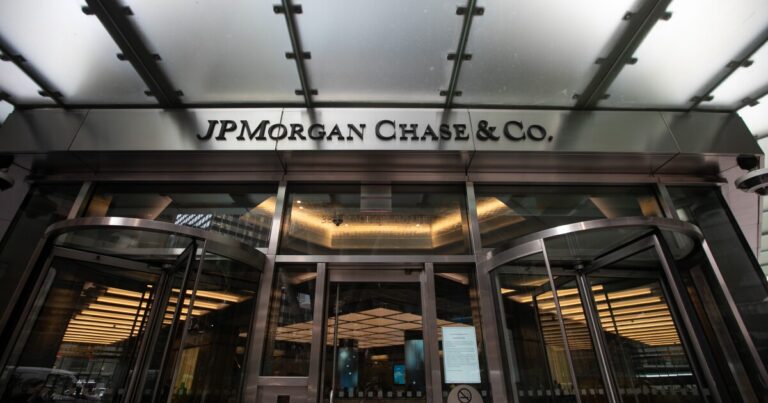Bloomberg
JPMorganChase is planning a digital currency that looks and sounds like a stablecoin. But there are differences that have major ramifications for what the cryptocurrency payments market will look like in the post-GENIUS Act world.
In an email to American Banker, the bank said it plans to issue a permissioned USD deposit token, JPMD, for payments on Base, a blockchain that is built within Coinbase. JPMD will launch “in the coming days,” the bank said.
“It’s going to be a big question in the near term as we see more institutions explore stablecoins: What’s a stablecoin, and what’s a deposit token?” James Wester, director of cryptocurrency research for Javelin Strategy & Research, told American Banker.
What are deposit tokens?
A deposit token is a digital asset that is a claim on a deposit at a licensed depository institution, such as a bank. Deposit tokens are issued on a distributed ledger, or the structure that underpins cryptocurrency. That makes deposit tokens easier to transfer between consumers or businesses, particularly in different countries.
Writing for American Banker, Igor Pejic, author of “Big Tech in Finance,” said that unlike fintech-issued stablecoins, “deposit tokens are not simply created by any private company, yet directly tied to deposits held at licensed banks. By utilizing existing banking infrastructure, deposit tokens benefit from a unified risk management framework and can even be eligible for deposit insurance.”
While deposit tokens are often referred to as “private stablecoins,” there is still a difference between JPMD and, say, Tether or USDC.
The big difference between a deposit token and a stablecoin is that a deposit token represents commercial bank deposits, rather than a claim on U.S. Treasuries, Aaron McPherson, principal at AFM Consulting, told American Banker. “As such, it has advantages, such as deposit insurance, but is tied more closely to the bank, creating lock-in, which some businesses may not want.”
What JPMorgan is launching
JPMD is not a stablecoin, according to Wester.
“It’s a tokenized claim on an existing bank deposit, fully governed by traditional banking regulation,” Wester said. “That may sound like a small distinction, but the key difference is that it doesn’t require new reserves or a third-party trust structure.”
It’s simply making deposit balances programmable but within the permissioned system JPMorgan is operating for its commercial clients, Wester said.
A JPMorgan digital asset unit called Kinexys Digital Payments is developing JPMD. Naveen Mallela, the global co-head of the unit, said JPMD and other deposit tokens match the novel and distinctive properties of stablecoins, most notably the ability to conduct peer-to-peer transactions with programmability.
“As such, deposit tokens and stablecoins can be applied to similar use cases,” Mallela told American Banker via email.
Today, stablecoins are primarily for retail use cases, including crypto trading, remittances and as a means to access U.S. dollars as a store of value, according to Mallela. Deposit tokens differ from stablecoins in key areas including interest payouts and deposit treatment, he said.
“Institutional clients can treat JPMD as bank deposits on their balance sheet, providing certainty around financial and accounting treatment,” Mallela said.
JPMD will also be integrated with JPMorgan’s traditional banking systems, thereby reducing liquidity silos for clients.
“For these reasons we believe that deposit tokens are a more compelling product offering for institutional clients than stablecoins,” Mallela said.
A role for banks
JPMorgan and other large banks are already active in deposit tokens. As early as 2022, JPMorgan developed Liink, a payment information network with dozens of banks that expanded JPM Coin, a digital currency JPMorgan launched in 2019 to support faster processing over a distributed ledger.
“Exchanging value, such as money, between different parties over a blockchain requires a digital currency, so we created the JPM Coin,” the bank wrote in an FAQ at the time.
Other banks are also active. Citigroup developed a digital token service to enable institutional clients to execute cross-border payments, manage liquidity and support trade finance at all times.
Stablecoins are a potential threat to banks since the underlying digital wallets could draw traditional bank deposits.
JPMorgan’s email announcement called JPMD an “alternative” to a stablecoin. The GENIUS Act, which passed the Senate, is expected to provide a regulatory framework for stablecoins that governs the assets that are designed to provide a 1:1 backing between traditional currency and the stablecoin. The GENIUS Act has drawn attention to stablecoins from sources as varied as Walmart and Amazon and a bank-led consortium.
By stressing a deposit token, JPMorgan is drawing attention to its existing scale, services and experience as a regulated and insured bank.
“From a market perspective, it shows banks are entering the digital asset and crypto space with compliance, control, and safeguards baked in, even before dedicated stablecoin legislation is finalized,” Wester said, adding that stablecoins and deposit tokens will likely coexist. “They serve different needs. But this move shows that the architecture of money is already changing.”
By using deposit tokens, banks could compete to offset some of the threat stablecoins pose to deposits.
But whether the gap between stablecoins and deposit tokens is a difference without distinction remains to be seen, Eric Grover, principal at Intrepid Ventures, told American Banker.
“Both in theory are flexible and efficient payment instruments enabling payment and settlement worldwide to be one transaction,” Grover said.
If banks like JPMorgan are sufficiently competitive in the flexibility and ease of use relative to stablecoin specialist issuers like Tether and Circle, many businesses will be more comfortable using them for payments, domestically and particularly for cross-border transactions, Grover said.
“Deposit tokens issued by regulated FDIC-insured banks would be more comfortable for businesses, not that stablecoins wouldn’t work,” Grover said.
For example, in countries with debased currencies and weak national payment systems, the likely more accommodative approach of specialists like Tether versus Chase may be more of a fit.
“A business in Caracas wants to operate in dollars rather than bolivars, but is that a use case JPM would support?” Grover said.
